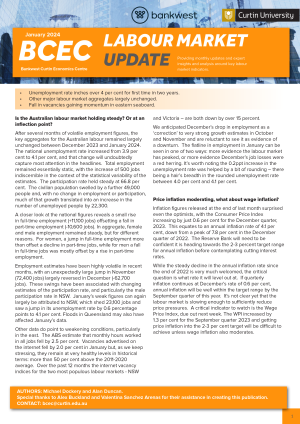BCEC Monthly Labour Market Update – January 2024
— Unemployment rate inches over 4 per cent for first time in two years. —
— Other major labour market aggregates largely unchanged. —
— Fall in vacancies gaining momentum in eastern seaboard. —
Is the Australian labour market holding steady? Or at an inflection point?
After several months of volatile employment figures, the key aggregates for the Australian labour market remained largely unchanged between December 2023 and January 2024. The national unemployment rate increased from 3.9 per cent to 4.1 per cent, and that change will undoubtedly capture most attention in the headlines. Total employment remained essentially static, with the increase of 500 jobs indiscernible in the context of the statistical variability of the estimates. The participation rate held steady at 66.8 per cent. The civilian population swelled by a further 49,000 people and, with no change in employment or participation, much of that growth translated into an increase in the number of unemployed people by 22,300.
A closer look at the national figures reveals a small rise in full-time employment (+11,100 jobs) offsetting a fall in part-time employment (-10,600 jobs). In aggregate, female and male employment remained steady, but for different reasons. For women, a jump in full-time employment more than offset a decline in part-time jobs, while for men a fall in full-time jobs was mostly offset by a rise in part-time employment.
Employment estimates have been highly volatile in recent months, with an unexpectedly large jump in November (72,400 jobs) largely reversed in December (-62,700 jobs). These swings have been associated with changing estimates of the participation rate, and particularly the male participation rate in NSW. January’s weak figures can again largely be attributed to NSW, which shed 23,100 jobs and saw a jump in its unemployment rate by 0.6 percentage points to 4.1 per cent. Floods in Queensland may also have affected January’s data.
Other data do point to weakening conditions, particularly in the east. The ABS estimate that monthly hours worked in all jobs fell by 2.5 per cent. Vacancies advertised on the internet fell by 2.0 per cent in January but, as we keep stressing, they remain at very healthy levels in historical terms: more than 50 per cent above the 2011-2020 average. Over the past 12 months the internet vacancy indices for the two most populous labour markets – NSW and Victoria – are both down by over 15 percent.
We anticipated December’s drop in employment as a ‘correction’ to very strong growth estimates in October and November and are reluctant to see it as evidence of a downturn. The flatline in employment in January can be seen in one of two ways: more evidence the labour market has peaked, or more evidence December’s job losses were a red herring. It’s worth noting the 0.2ppt increase in the unemployment rate was helped by a bit of rounding – there being a hair’s breadth in the rounded unemployment rate between 4.0 per cent and 4.1 per cent.
Price inflation moderating, what about wage inflation?
Inflation figures released at the end of last month surprised even the optimists, with the Consumer Price Index increasing by just 0.6 per cent for the December quarter, 2023. This equates to an annual inflation rate of 4.1 per cent, down from a peak of 7.8 per cent in the December quarter of 2022. The Reserve Bank will need to be confident it is heading towards the 2-3 percent target range for annual inflation before contemplating cutting interest rates.
While the steady decline in the annual inflation rate since the end of 2022 is very much welcomed, the critical question is what rate it will level out at. If quarterly inflation continues at December’s rate of 0.6 per cent, annual inflation will be well within the target range by the September quarter of this year. It’s not clear yet that the labour market is slowing enough to sufficiently reduce price pressures. A critical indicator to watch is the Wage Price Index, due out next week. The WPI increased by 1.3 per cent for the September quarter 2023 and getting price inflation into the 2-3 per cent target will be difficult to achieve unless wage inflation also moderates.




